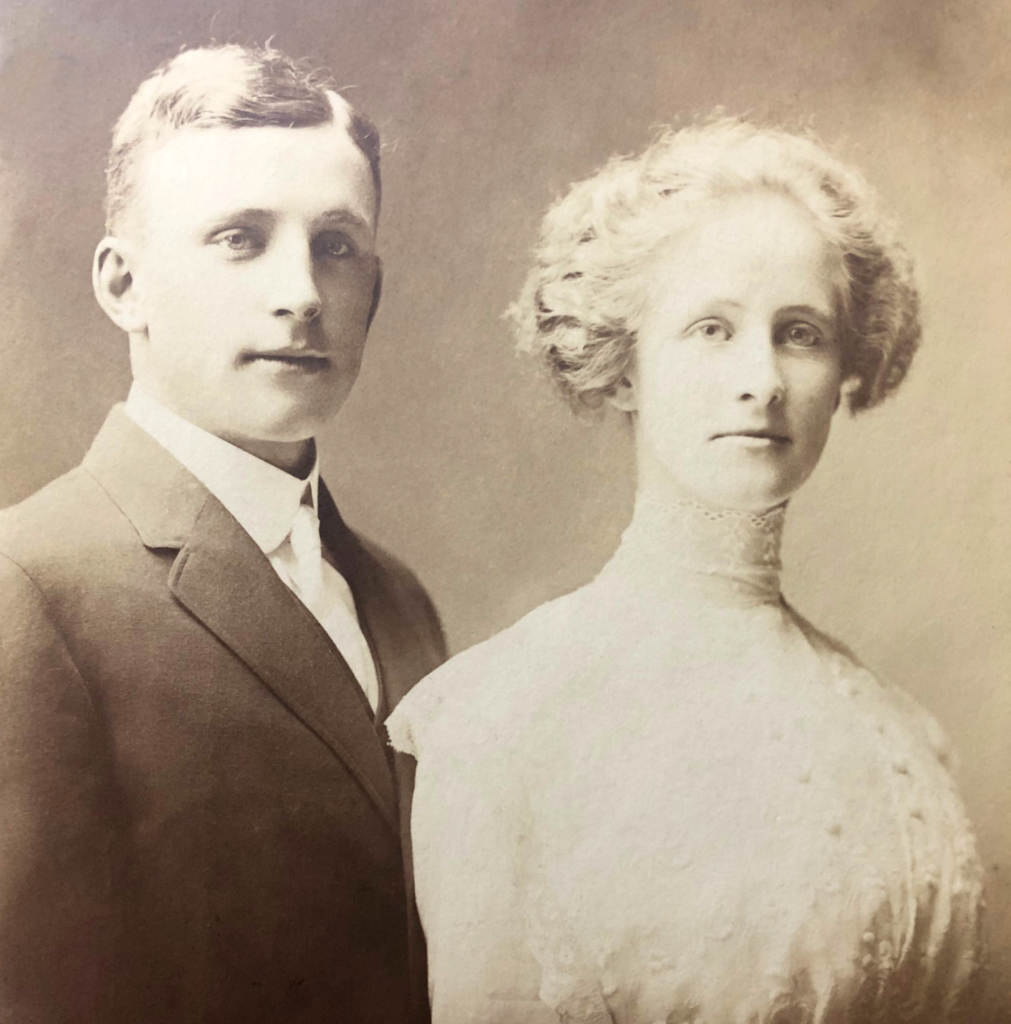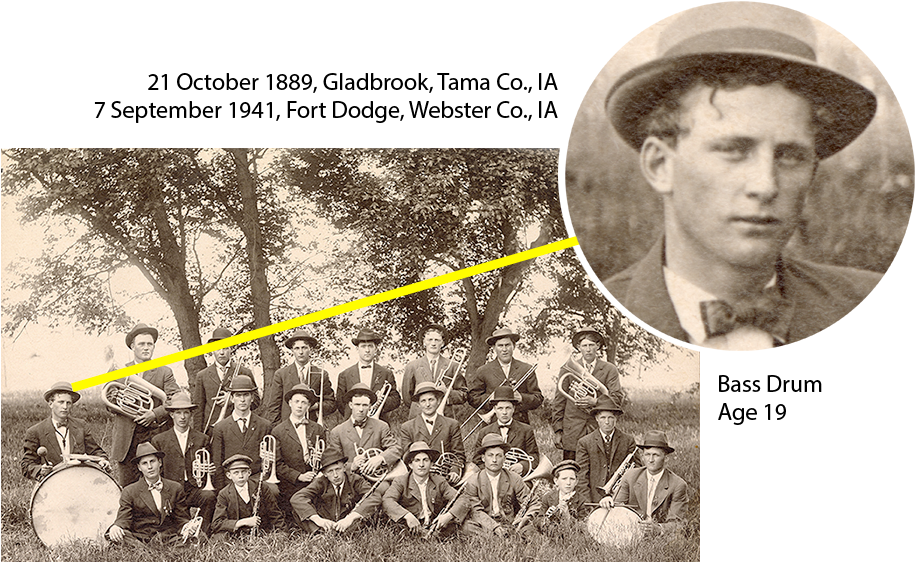
John Mehrens (he had no middle name) was a son of Claus Mehrens (1847-1924) and Mathilda Schmidt (1857-1924).(1) He and his brother Albert Mehrens (1891-1957), also a Calumet German Band member, grew up on the family farm in Liberty Township, O’Brien County. As noted on other band member bios, John and Albert Mehrens were one of three sets of brothers who were in the band. The others were Harry Rochel (1883-1965) and Charles Rochel (1888-1967), and William Shafer (1888-1954) and Ernest Shafer (1891-1964). In other words, six of the 22 band members comprised pairs of siblings.
Like many other band members’ families, the Mehrenses reflected a typical migration pattern for German immigrants of this era. Claus was born in Schleswig-Holstein. After emigration, he settled first in Tama County, Iowa, in the east central part of the state. Many German immigrants of the late 19th century ended their journey or laid over in Scott County because the passenger railroad crossed the Mississippi River there. Some families remained in Scott County or moved on to Tama, the locus of a strong German community, or they moved further west, to northwest Iowa or the Dakotas.
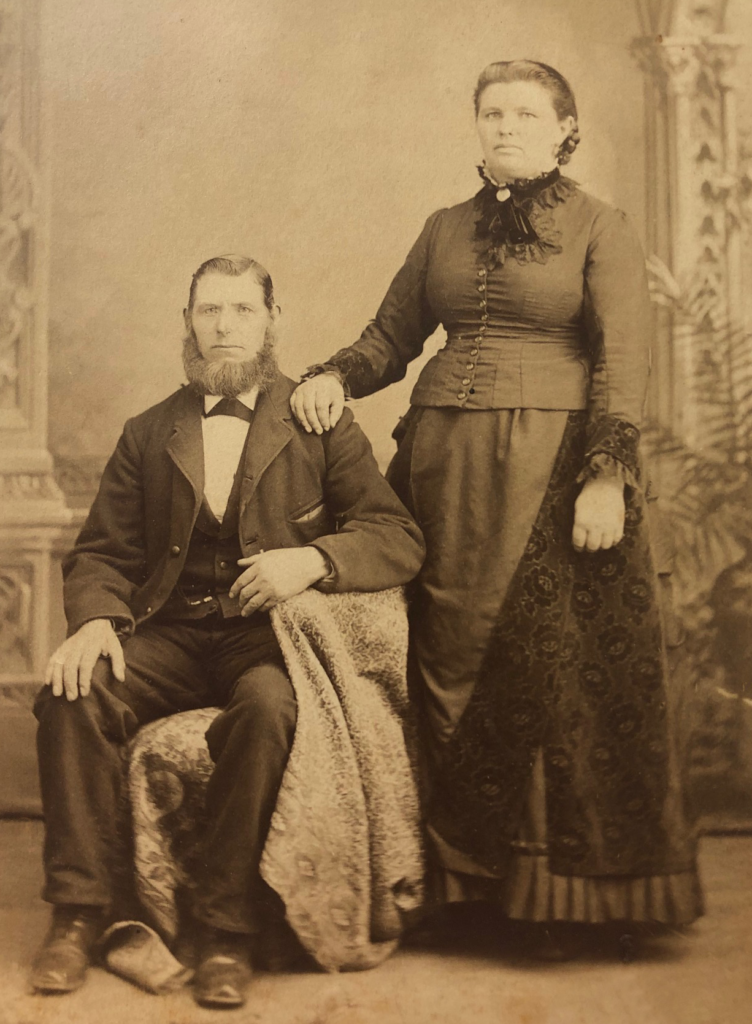
The Mehrens family also reflected an all-too-common pattern of family life in this era: a youthful marriage, the early death of a young spouse, remarriage, and the forming of a second family. In 1870, Claus married Katharina Schmidt (1849-1881) in Scott County, who was another immigrant from Schleswig-Holstein. They had four children: Henry Claus (1870-1922), Emma (1875-1936), Gustave Henry (1880-1932), and Agnes (1880-1935). (Agnes was born a mere nine months after Gustave — Gustave in January and Agnes in October.) But Katharina died in 1881, at age 32, leaving Claus with four young children. His remarriage, on 10 January 1882, was to Katharina’s younger sister, Mathilda.
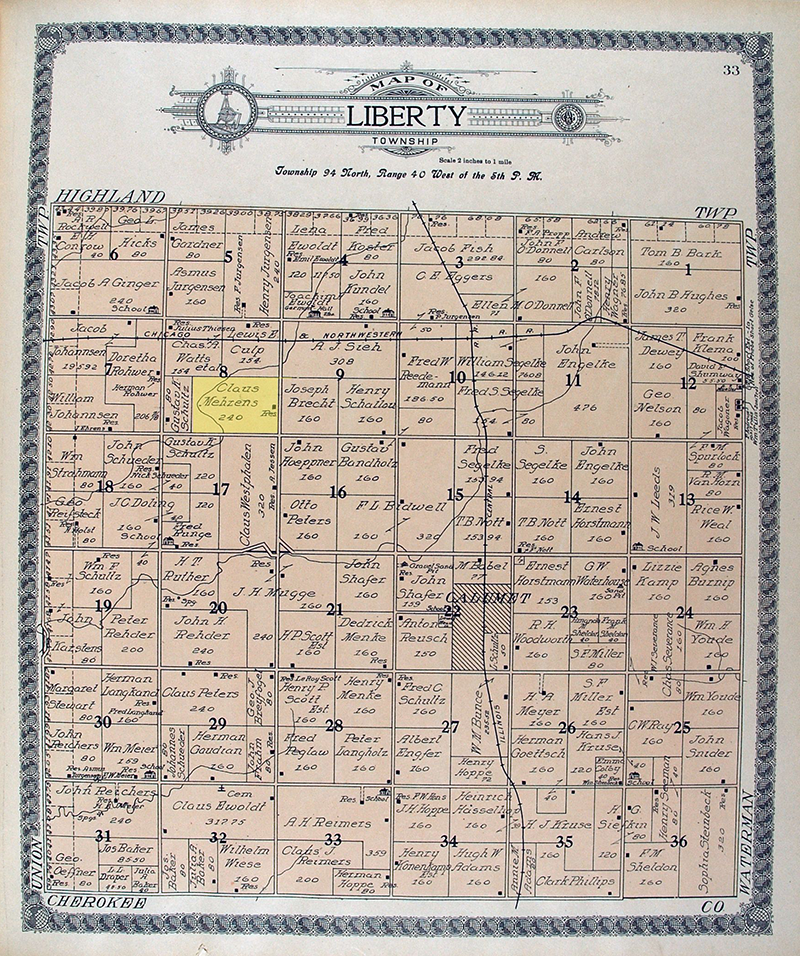
Claus continued to farm in Tama County for several years after this marriage, and two more children — John and Albert — were born there. But the family then moved, in 1894, to O’Brien County. The Mehrens farm was in Section 8 of Liberty Township, northwest of Calumet. There another son, Elmer (1897-1955), was born. By the 1900 census, the two older children had left the household, and five siblings and half-siblings remained: Gustave, Agnes, John, Albert, and Elmer. In 1909, when the Calumet German Band photo was taken, Albert and John were still part of the household. By 1920, Claus and Mathilda had retired to the town of Calumet.
On 19 February 1913, John Mehrens married Anna Christina Steen (1889-1983), who had been born in Paullina to parents who also reflected a German heritage (Theodore Henry Jacob Steen, 1862-1924, and Christina Wolleson, 1871-1950).
John and Anna farmed for several years after the marriage, and they had two children, Donald Milton Mehrens (1914-1998) and Ruth Allene (“Allie”) Mehrens (1921-2005). But in June 1924, the family moved to Calumet, where John and Anna made their home for the remainder of their lives.

That move took place because John decided to enter into the grain elevator and lumber business; he purchased the Calumet Elevator in March 1924 from L. O. Bidwell.(2) The Sutherland Courier, in reporting on the sale, stated that “Mr. Mehrens, the new manager, is a progressive farmer who is well acquainted in the community and is well qualified to conduct the elevator business successfully.” The business was indeed successful, over the decades of John Mehrens’s management. Its peripheral retail sales — everything from coal for home heating to lumber and animal feed — would have paled in comparison to the much larger business of purchasing grain, which in this era was being bountifully produced by Liberty Township farms, and selling it on the larger commodity markets regionally and out of state. The Calumet Elevator, situated on the all-important rail line through town, would have been an important transfer point for oats, barley, corn, soybeans, and other field crops.
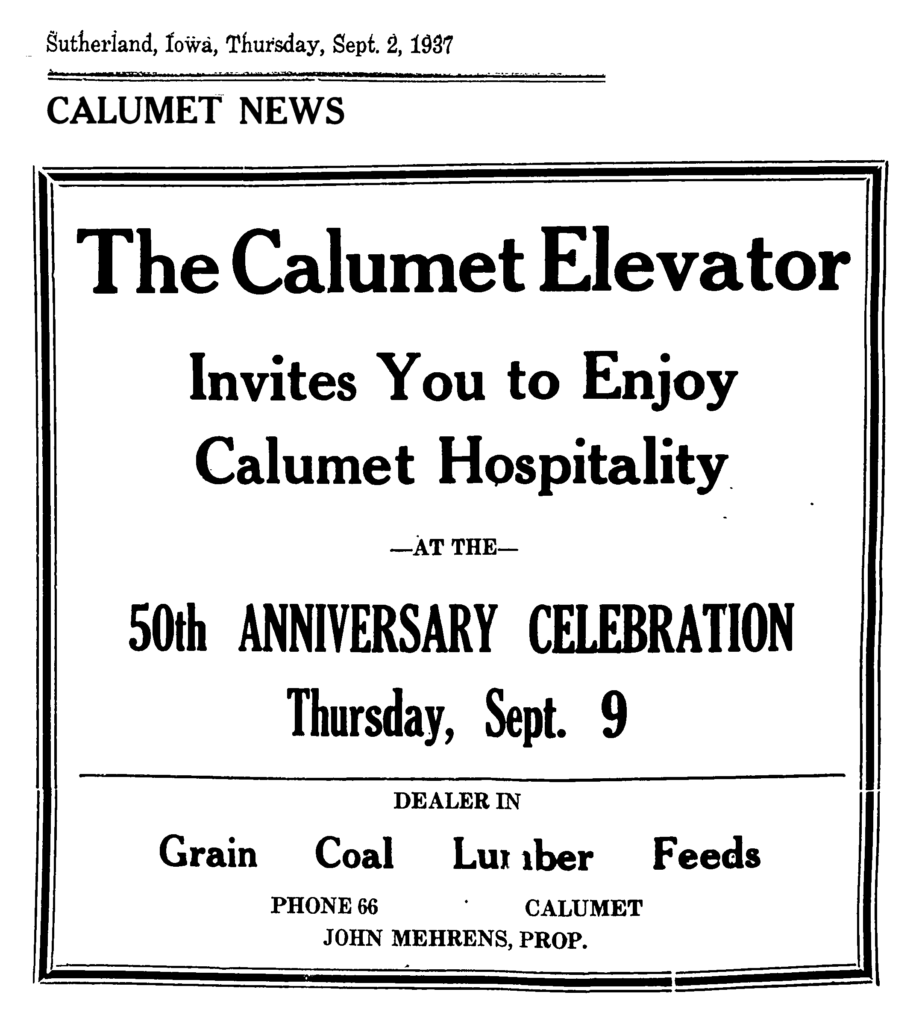
John Mehrens also was intensely involved in civic and social affairs in the community. Over the years he served on the Calumet school board, was a notary public, managed and played on town baseball teams, participated in a Calumet town band (in a later era than the Calumet German Band), served in leadership roles with the German Lutheran church community in Calumet (Zion Evangelical and Reformed Church(3)), and also served as constable and Calumet mayor.

The sudden death of this prominent businessman and civic leader, at age 52, came as a shock to the community. He died from a heart attack, which occurred in Fort Dodge (Webster County), while the family was traveling to take daughter Allie to enroll at Drake University in Des Moines. He did not live to see the marriage of either his son, Donald, who married Barbara Ruth Burrington (1920-2007) in 1943, or of Allie, to Carl William Hoffman (1919-2016) in 1945.
These two children achieved success and a measure of fame in their own lives. Donald was a dentist and orthodontist, practicing for decades in Sioux Falls, South Dakota. Allie, a singer, carried on her father’s affinity for music. She had often performed during church services at the Calumet church in her youth, and she went on to complete a degree in music at Drake University. Later she taught music, played the trumpet, and had a musical collaboration with her husband, Carl Hoffman. Hoffman was a Major General in the U.S. Marine Corps, earning the Silver Star and two Purple Heart medals during World War II operations on Guadalcanal, Tarawa, Saipan, and Tinian, completing combat tours in Korea and Vietnam, and serving as the commanding general at several Marine Corps bases in California. But he also — perhaps against type — was a music arranger and leader of a dance band and choral groups. Allie and Carl performed together even before their marriage and continued to do so throughout their lives.

Anna Steen Mehrens lived for another four decades following John Mehrens’s death. They are both buried in Liberty Cemetery near Calumet.

Subscribers to Ancestry.com may wish to further explore some family connections of John Mehrens by accessing an Ancestry profile page (within the context of a “Mugge Family Tree”).
Connection to Other Band Members
See the biosketch page for Albert Mehrens (1891-1957), Calumet German Band member and brother of John Mehrens.
A future marriage would create an in-law relationship between John Mehrens (and his brother Albert) with William “Bill” Eggers (1886-1968). John and Albert’s brother Elmer William Mehrens (1897-1955) in 1924 married Alice Meier (1906-1982), who was a niece of Bill Eggers. Alice was the daughter of Bill’s sister Amanda Eggers (1884-1938) and Edward W. Meier (1878-1913). See a schematic of this relationship.
And there is a complex family connection to band member Henry W. Mugge (1891-1967). John Mehrens’s sister-in-law, Matie Rohwer (1880-1954), who was the wife of another half-brother of John and Albert — Gustave Henry Mehrens (1880-1932) — was a sister of Dorothea Henrietta Rohwer (1872-1925), whose husband Henry Schierholz (1874-1964) was a first cousin of Bernhart “Ben” Schierholz (1882-1962). Ben Schierholz was a brother-in-law of Henry Mugge: Ben’s wife Elizabeth “Lizzie” Emma Kundel (1888-1969) was a sister of Henry Mugge’s wife Lillie Kundel (1892-1960). Again, a schematic, available here, is probably the best way to understand this complicated relationship.
Connection to the Mugges
In addition to the familial connection noted above, there are also neighbor connections between the Mehrens and Mugge families.
The Mehrens farm where John and Albert were raised was one mile west of the Henry Schallau farm, which beginning in 1952 was farmed by Henry Mugge’s son Lyle John Mugge (1915-2000) and since 1976 by Lyle’s son Paul Henry Mugge (b. 1951). And the Mehrens farm was near that of Johann Hermann Mugge (1865-1931), father of Henry Mugge. (The J. H. Mugge farm was later farmed by other members of the Mugge family.)
Another connection involves John Mehrens’s brother Albert. See the Mugge-family section of the Albert Mehrens biosketch for that connection.
Footnotes
(1) Some of the opening material for this biosketch repeats information that appears on the bio for John’s brother, Albert Mehrens.
(2) Lester Orlando Bidwell (1886-1953), who incidentally was a first cousin of Calumet German Band member Newell Bidwell (1896-1918).
(3) The church had been established in 1891 as the German Evangelical Lutheran Church. The word “Lutheran” was dropped from the name in 1920, and at a later point it became the Zion Evangelical and Reformed Church. Still later, upon its joining the United Church of Christ denomination, it became known as the Zion United Church of Christ. It continues under that name to the present day.

